
James Charles Laker was an English professional cricketer who played for Surrey County Cricket Club from 1946 to 1959 and represented England in 46 Test matches. He was born in Shipley, West Riding of Yorkshire, and died in Wimbledon, London.

Frederick Sewards Trueman, was an English cricketer who played for Yorkshire County Cricket Club and the England cricket team. He had professional status and later became an author and broadcaster.

Lancashire Cricket Club represents the historic county of Lancashire in English cricket. The club has held first-class status since it was founded in 1864. Lancashire's home is Old Trafford Cricket Ground, although the team also play matches at other grounds around the county. Lancashire was a founder member of the County Championship in 1890 and has won the competition nine times. Lancashire has won 26 major honours in its history. The club's men's limited overs team is called Lancashire Lightning and women's team is Lancashire Thunder.

Yorkshire County Cricket Club is one of eighteen first-class county clubs within the domestic cricket structure of England and Wales. It represents the historic county of Yorkshire. Yorkshire's first team is the most successful in English cricketing history with 33 County Championship titles, including one shared. The team's most recent Championship title was in 2015. The club's limited overs team is called the Yorkshire Vikings and their kit colours are Cambridge blue, Oxford blue, and yellow.

Hedley Verity was a professional cricketer who played for Yorkshire and England between 1930 and 1939. A slow left-arm orthodox bowler, he took 1,956 wickets in first-class cricket at an average of 14.90 and 144 wickets in 40 Tests at an average of 24.37.

Sydney Francis Barnes was an English professional cricketer who is regarded as one of the greatest bowlers of all time. He was right-handed and bowled at a pace that varied from medium to fast-medium with the ability to make the ball both swing and break from off or leg. In Test cricket, Barnes played for England in 27 matches from 1901 to 1914, taking 189 wickets at 16.43, one of the lowest Test bowling averages ever achieved. In 1911–12, he helped England to win the Ashes when he took 34 wickets in the series against Australia. In 1913–14, his final Test series, he took a world record 49 wickets in a Test series, against South Africa.
John Brian Statham, was an English professional cricketer from Gorton, in Manchester, who played for Lancashire County Cricket Club from 1950 to 1968 and for England from 1951 to 1965. As an England player, he took part in nine overseas tours from 1950–51 to 1962–63. He was a right arm fast bowler and was noted for the consistent accuracy of his length and direction.
Lancashire County Cricket Club played cricket in Division Two of the County Championship and Division One of the totesport League in the 2005 English cricket season. After their shock relegation last season, they were 11–10 favourites to win the Second Division of the Championship, and they managed this with seven wins and a total of 212 points. They also survived in Division One of the National League, beating Worcestershire Royals on the last matchday to stay up. Lancashire also qualified for the final of the Twenty20 Cup, but lost by seven wickets to Somerset Sabres.
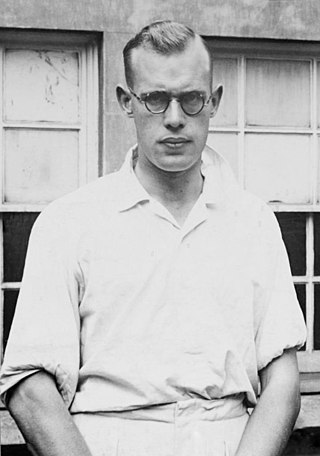
William Eric Bowes was an English professional cricketer active from 1929 to 1947 who played in 372 first-class matches as a right arm fast bowler and a right-handed tail end batsman. He took 1,639 wickets with a best performance of nine for 121 and completed ten wickets in a match 27 times. He scored 1,531 runs with a highest score of 43* and is one of very few major players whose career total of wickets taken exceeded his career total of runs scored. He did not rate himself as a fielder but he nevertheless held 138 catches.
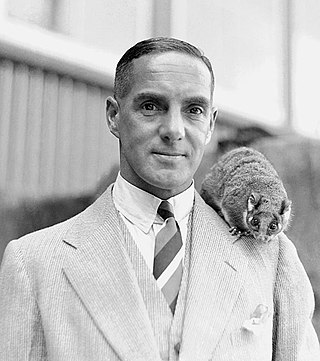
Herbert Sutcliffe was an English professional cricketer who represented Yorkshire and England as an opening batsman. Apart from one match in 1945, his first-class career spanned the period between the two world wars. His first-class debut was delayed by the First World War until 1919 and his career was effectively terminated in August 1939 when he was called up for military service in the imminent Second World War. He was the first cricketer to score 16 centuries in Test match cricket. He is most famous for being the partner of Jack Hobbs and the partnership between the two, Hobbs and Sutcliffe, is widely regarded as the greatest partnership of all time.

Trevor Edward Bailey was an England Test cricketer, cricket writer and broadcaster.

John Thomas Tyldesley was an English cricketer who played first-class cricket for Lancashire and Test cricket for England. He was a specialist professional batsman, usually third in the batting order, who rarely bowled and generally fielded in outfield positions.
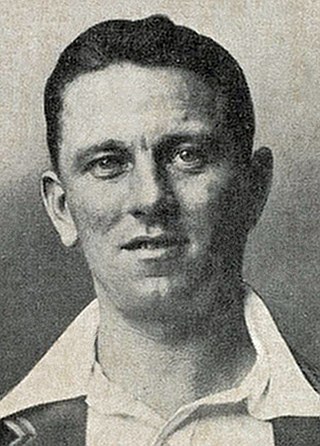
Maurice Leyland was an English international cricketer who played 41 Test matches between 1928 and 1938. In first-class cricket, he represented Yorkshire County Cricket Club between 1920 and 1946, scoring over 1,000 runs in 17 consecutive seasons. A left-handed middle-order batsman and occasional left-arm spinner, Leyland was a Wisden Cricketer of the Year in 1929.
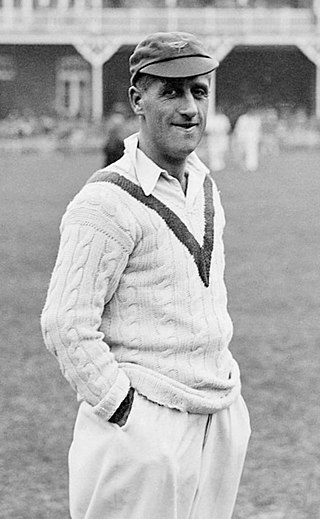
Percy Holmes was an English first-class cricketer, who played for Yorkshire and England.
Emmott Robinson was an English first-class cricketer, who played for Yorkshire County Cricket Club from 1919 to 1931. He was awarded his county cap in 1920. Robinson was a right-handed batsman who bowled right-arm fast-medium pace.
Ellis Pembroke Robinson was an English first-class cricketer who took over 1,000 first-class wickets for Yorkshire from 1934 to 1949, and Somerset from 1950 to 1952.
Melville Ryan was an English professional cricketer who played for Yorkshire County Cricket Club from 1954 to 1965. He was born in Huddersfield, and died in the Kirkland Hospice at Dalton in Huddersfield.
John Shaw Waring was an English professional cricketer who played for Yorkshire County Cricket Club from 1963 to 1966. He also played one match for Warwickshire in 1967. He was born in Ripon.
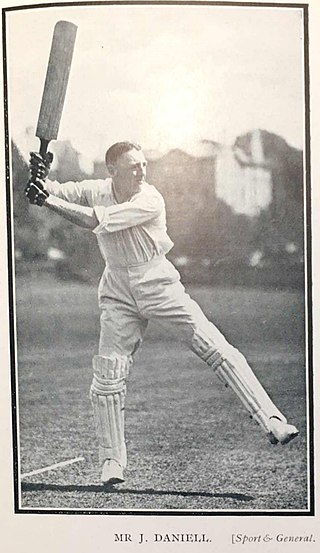
John Daniell was an international rugby union player for England and a first-class cricketer for Somerset and Cambridge University Cricket Club.

Headingley Cricket Ground is a cricket ground in the Headingley Stadium complex in Headingley, Leeds, England. It adjoins the Headingley Rugby Stadium through a shared main stand, although the main entrance to the cricket ground is at the opposite Kirkstall Lane end. It has hosted Test cricket since 1899 and has a capacity of 18,350.














